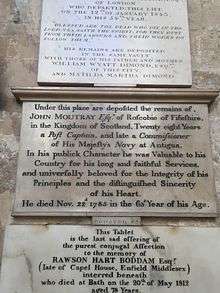John Moutray
John Moutray (c.1722 – 22 November 1785) was an officer of the Royal Navy.[1] He reached the rank of post-captain and served as the Royal Commissioner for English Harbour in Antigua.[2][3][4]
Biography
He was born c. 1722. He was married to Mary Moutray on 2 September 1771.[5]
He was promoted to post-captain on 28 December 1758.[4][6]
On 29 July 1780 a convoy of 63 ships were bound for the East Indies and West Indies. They left Great Britain under the care of Captain John Moutray in the 74-gun HMS Ramillies, and accompanied by the 36-gun frigates HMS Thetis and HMS Southampton.
On 8 August 1780 unusual sails were seen, and Moutray signalled his ships to alter course and follow him close to the wind. They paid no attention to his orders, and by daylight on 8 August 1780 a combined Franco-Spanish fleet had captured the bulk of the convoy.[3][4]
The warships escaped with eight of the convoy; the other 55 merchantmen were captured, with the loss of their cargoes worth a million and a half, and 2,805 prisoners. It was a blow to British commerce, and especially to the forces in the West Indies, which lost a vast quantity of military stores.[3][4]
The merchants at home were so enraged, Captain Moutray had to be made a scapegoat. He was tried by court-martial, which dismissed him from his ship. However, before long he was again employed.[3][4]
He went on to become the Commissioner of the naval dockyard in the Leeward Islands from April 1784 until 1785, where he became friends with Cuthbert Collingwood and Horatio Nelson. He died on 22 November 1785 in Bath, Somerset at the age of 62. He was buried at Bath Abbey four days later. He left his estate to his wife and children. His will also refers to two children he had by a woman named Elspeth London.[7]
Memorials

Buried at Bath Abbey, His epitaph reads:
Under this place are deposited the remains of John Moutray Esq of Roscobie in Fifeshire in the Kingdom of Scotland twenty eight years a post captain and late a Commissioner of His Majesty's Navy in Antigua. In his public character he was valuable to his country for his long and faithful services and universally beloved for the integrity of his principles and the distinguished sincerity of his heart. He died 22 Nov 1785 in the 63rd year of his age".[8]
References
- ↑
 John Knox Laughton (1894). "Moutray, John". In Lee, Sidney. Dictionary of National Biography. 39. London: Smith, Elder & Co.
John Knox Laughton (1894). "Moutray, John". In Lee, Sidney. Dictionary of National Biography. 39. London: Smith, Elder & Co. - ↑ R. J. B. Knight (2005). The pursuit of victory: the life and achievement of Horatio Nelson.
This pennant represented the intention of the resident commissioner of the dockyard, Captain John Moutray (a civilian appointment without an Admiralty commission), to be recognized as the senior officer at English Harbour, ...
- 1 2 3 4 Court Martial of Captain John Moutray. Great Britain Navy Court. 1990.
- 1 2 3 4 5 William Laird Clowes (1899). The Royal Navy: A History From the Earliest Times to the Present.
On July 29th, a convoy of sixty-three valuable ships, bound for the East and West Indies, left Great Britain under the care of Captain John Moutray in the BamiUies, 74, with the frigates Thetis and Southampton, both of 36 guns.' On August 8th, in lat. 36^ 40' N., long. 15' W., strange sails were seen, and Captain Moutray signalled his ships to alter course and follow him close to the wind. They paid no attention to his orders, and by daylight of the 9th the bulk of the convoy found themselves close to the enormous combined Franco-Spanish fleet. The warships, wath eight of the convoy, alone escaped ; the other fifty-five merchantmen, with 2805 prisoners, and cargo worth a million and a half, were captured. It was a terrible blow to British commerce, and especially to the forces in the West Indies, which lost a vast quantity of military stores. The merchants at home were so enraged that Captain Moutray had to be made a scapegoat. He was tried by court-martial and dismissed his ship, but w'as again employed before long. Early in July, the outward bound Quebec fleet was attacked on the Newfoundland Banks by privateers, and about fourteen of its richest ships were carried off.
- ↑ Tony Perrottet. "The Aristocrats of Antigua". Retrieved 2010-05-07.
But Nelson seemed envious of the white Antiguans' lives of luxury, raised aloft in their breezy plantation houses, while he spent his nights in cramped quarters, 'woefully pinched by mosquitoes.' In fact, Horatio wrote bitterly, if it wasn’t for the genteel company of a young woman named Mary Moutray — the wife of the local Commissioner 'I should almost hang myself in this infernal hole.'
- ↑ Horatio Nelson. The Dispatches and Letters of Vice Admiral Lord Viscount Nelson.
Captain John Moutray, the Commissioner at Antigua, was made a Post-Captain on the 28th of December 1758, and was by twenty-one years Nelson's senior Officer.
- ↑ "Monument of the Month". Retrieved 2010-05-07.
Moutray’s health was already failing, and he and his wife returned to England. He died at Bath on 22nd November 1785, at the age of sixty-two. Although he left his estate to his wife and their children, his will also refers to two illegitimate children he had by a woman called Elspeth London.
- ↑ "Maritime Memorials". National Maritime Museum. Retrieved 2010-05-07.